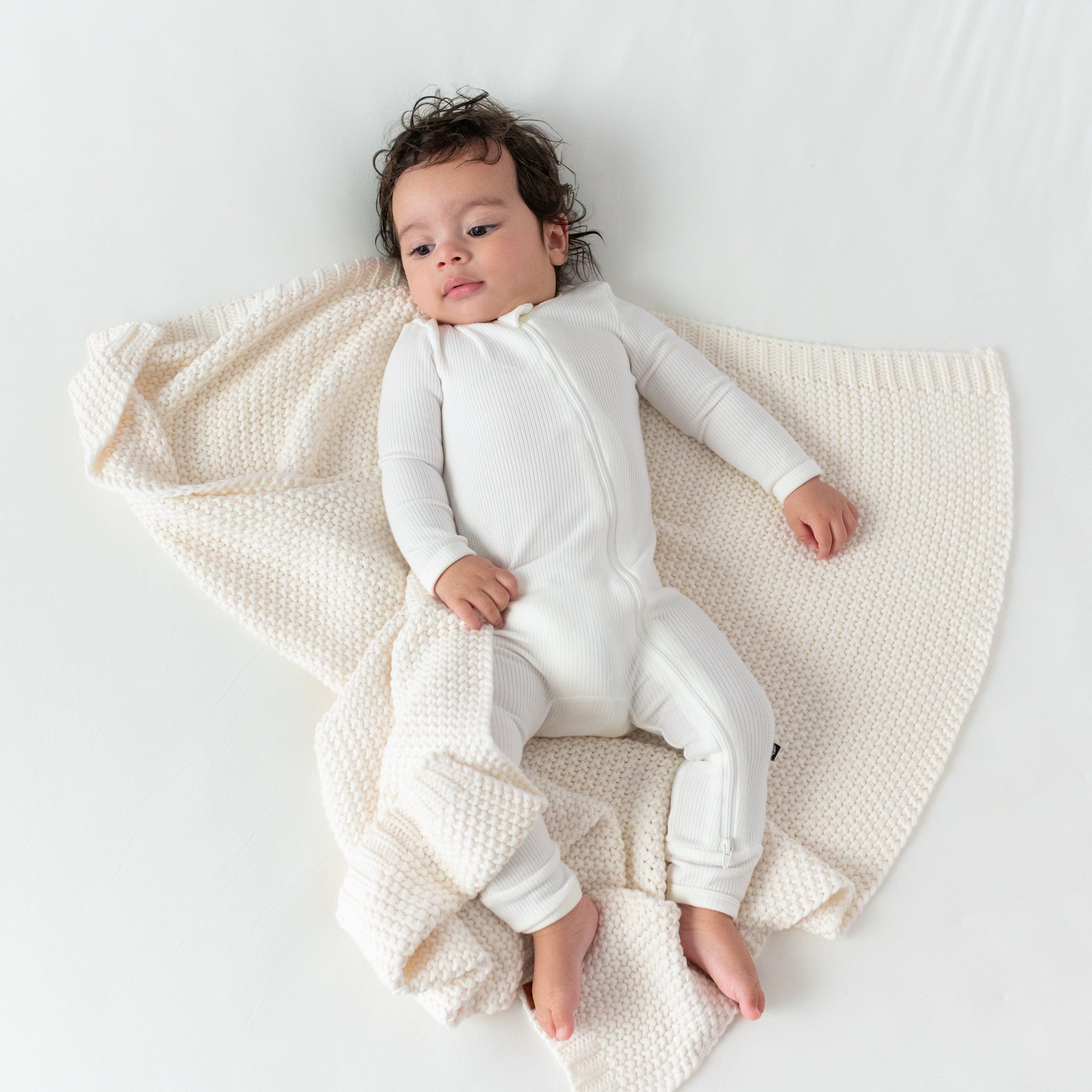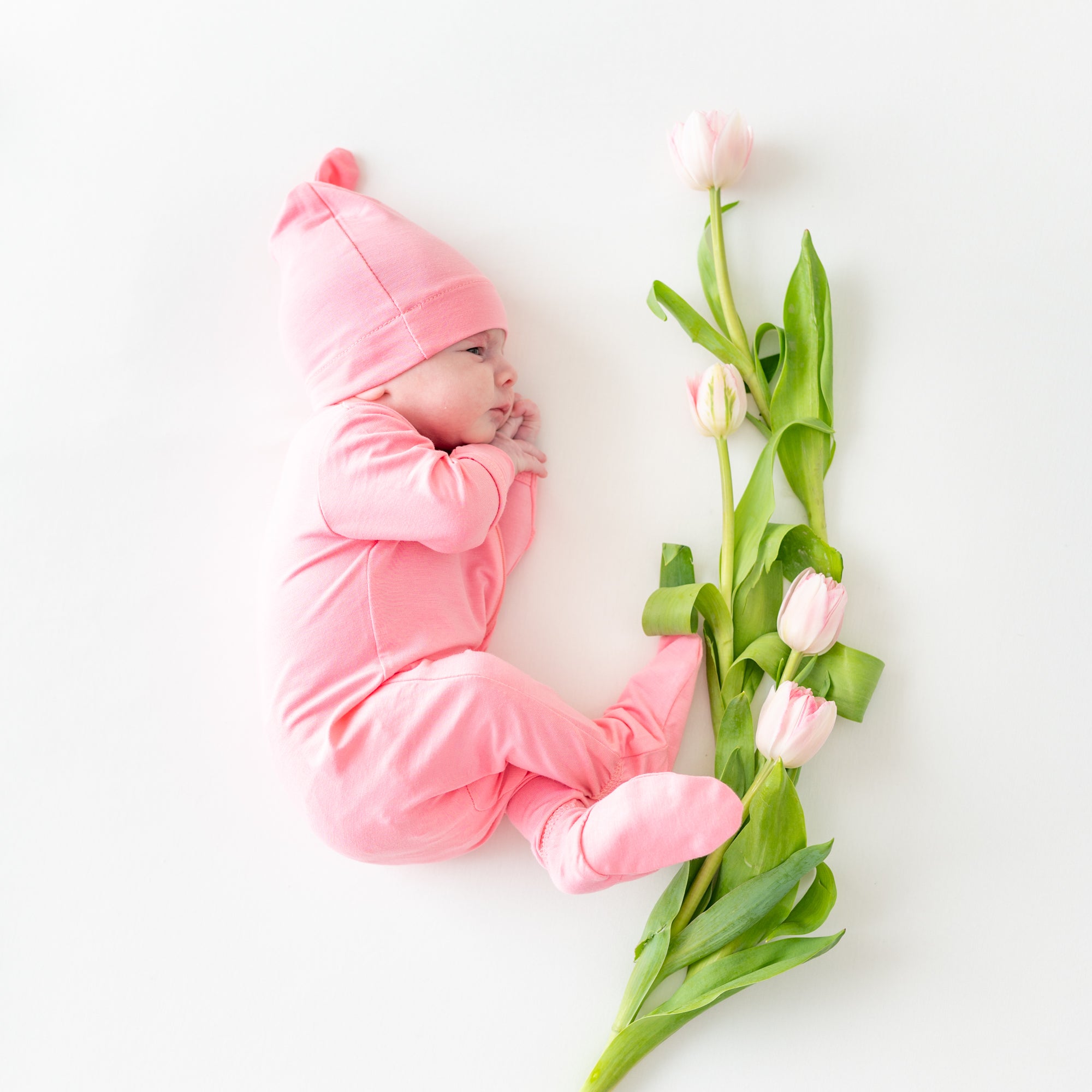
It is no secret that I am a huge fan of white noise! For myself, for babies, everyone!
So what is infant white noise? It is no different than any other white noise.
An infant white noise machine plays a sound that masks out other sounds, like if you live near railroad tracks, or in a busy city. This would keep the sounds from being really sudden and waking you.
That is the benefit of white noise-- it is not the noise itself that wakes you, but the noise coming out of nowhere! By masking this, it gives our brain the benefit of a more consistent environment.
Some people prefer to use sounds like rain, waves, or classical music. Others will prefer a static or fan type noise! It does not really matter, so long as you pick one that does not disturb your sleep more than it helps you sleep.
We will cover all the science behind white noise, which is the best white noise to use, how to use it safely, and pros and cons, plus other frequently asked questions like:
- White noise infant sleep?
- Is white noise bad for babies?
- What is white noise for a baby?
- When should you stop white noise for baby?
- Why does white noise help colic babies?
- Best infant white noise machine?
- Does it damage infant hearing or lead to developmental delays?
- What kind of white noise is available?
The Science Behind Infant White Noise
White noise is a mix of all different pitches of sounds blended together. There are different “colors” of white noise that are on different frequencies.
You can think of white noise as 20,000 tones all playing at the same time.
Because our brains continue to process sensory stimuli while we are sleeping, white noise helps to minimize the patterns or sudden changes in environmental noises that our brain would pick up on.
Thus giving us a more restful night of sleep!
Sounds that are maybe slightly annoying during the day can become more of a problem at night, especially when they are abrupt. Even if you don’t fully wake up, noises can arouse you slightly and affect sleep cycles.
There are many potential sources of sleep stealing sounds, ranging from things in the home like appliances, televisions, pets and other people, as well as outside sounds like storms, traffic and urban city noise.
Fun fact: “This research is finding that noise events induce arousals at relatively low exposure levels, and independent of the noise source (air, road, and rail traffic, neighbors, church bells) and the environment (home, laboratory, hospital).
New epidemiological studies support already existing evidence that night-time noise is likely associated with cardiovascular disease and stroke in the elderly. These studies collectively also suggest that nocturnal noise exposure may be more relevant for the genesis of cardiovascular disease than daytime noise exposure.”
White noise infant sleep and what is white noise for a baby?

While your baby is in the womb, they become accustomed to all the sounds our bodies make, such as from our digestive system or the rushing of blood through the placenta.
Therefore, when they are born into the environment with varying levels of sound, the quietness is disconcerting and they can actually have a harder time settling, not the other way around!
Fun fact: the decibel level of your womb is on average ~80 decibels.
Remember when you got an ultrasound and as soon as the wand was placed on your belly, you could hear the whooshing sound? Imagine that, amplified-- that is what your baby is listening to 24/7.
So when they enter the world of silence, whispers, tip toes as opposed to the very loud sound level of your womb, you can end up with a fussy, disoriented baby who prefers to fall asleep in the car or during a loud party than their quiet and still nursery.
This is the foundation of the 5 S’s by Dr. Harvey Karp, creator of the Snoo.
His theory is that the 5 S’s (swaddle, side, shh (loudly), suck (pacifier/breast), and swing (motion) all initiate a calming reflex in your baby. To use these, you would match the level of crying with your white noise/shh and motion until they start to calm.
Then you also lower your volume/movement until they are calm and/or asleep.
Which is the best white noise to use?
You will want to choose white noise machines that have non-repeating, sound stories (sounds taken from natural surroundings like ocean, waterfall, train, city, etc.), white noise and fan sounds that are dynamically generated using an algorithm that creates a truly random sound.
Certain white noise machines and phone apps use looping sound clips that wake your brain, while others use actual fans that can’t get loud enough to block out anything.
Your brain will identify a pattern and become more stimulated, waking you more often instead of improving your sleep!
How to use infant white noise safely?

It is important to measure the decibel level of your white noise machine; there are free apps that you can download to measure what level the machine is with your phone in their sleep space.
The American Academy of Pediatrics says the recommended noise level for infants is 50 dBA, in hospital nurseries.
This was recommended in 1999 by the National Resource Center and has nothing to do with protecting infants’ hearing.
It was set for neonatal intensive care units, or NICUs, with the primary objective being “to preserve a large portion of each hour for infant sleep.” Sleep is crucial for premature infants, and loud noises startle and bother NICU babies more than they disturb full-term healthy babies, so the limit primarily exists to help premature babies snooze better.
That’s funny, because helping babies sleep better is, of course, exactly why parents use white noise machines. The 1999 report even addressed whether loud NICUs might hurt premature infants’ ears and concluded that, “not surprisingly,” harmful effects from loud NICU noise “have not been demonstrated consistently.”
The current safety limit set by the U.S. National Institute for Occupational Safety and Health for workers is 85 decibels exposed for eight-hour stretches.
To compare, 50 decibels is the sound level associated with moderate rainfall; 60 decibels corresponds to the noise of typical conversation; 70 decibels is comparable to the sound of a vacuum cleaner; and blenders and blow-dryers emit 80 to 90 decibels.
According to Dr. Harvey Karp, founder of Happiest Baby on the Block and creator of the Snoo, “Sound doesn’t start boosting sleep until it gets to 60 to 65 dB.”
The American Academy of Pediatrics recommends a sound machine be placed seven feet away from where your child is sleeping.
This recommendation is from a study that showed infant white noise machines that were specifically marketed for babies, when placed within a foot of their sleep space, measured at decibel levels higher than the “recommended” amount.
Needless to say, don’t blast your white noise on full volume right next to your child’s head for 8 hours straight.
The intensity and severity of which noise impacts sleep is somewhat individual though, and some people are more sensitive than others. One study found that brain rhythms play a role in people’s ability to tolerate noise.
Pros and Cons of White Noise Infant

There are so many benefits to using white noise! Here are a list of pros:
- This study showed that 80% of babies fell asleep within 5 minutes of using white noise.
- Using “pink” noise (another form of white noise) showed improvements in memory
- It can block out household noises that may wake baby up early or throughout the night (imperative for room sharing!)According to this study, “[We investigated] if, during sleep, the brain responds in a different fashion to different stimuli as a function of their significance. Behavioral and electrophysiological evidence support this possibility. For example, some auditory stimuli produce more awakenings than others regardless of their intensity; e.g., young mothers are woken up by their infants' lightest movements”
- Has been proven to decrease the amount of time it takes to fall asleep, increase the amount of time spent in restorative sleep, and decreases the time to transition sleep cycles
- Positive effects if you suffer from insomnia (decreases the time it takes to fall asleep)
- Babies get stressed by the stimulation of lights, faces and excitement. White noise creates a safe space by blocking out stimulation when they need to sleep.
- Babies who are napping hit a sleep arousal at about 20 to 45 minutes. Using white noise can block the sounds of siblings or the doorbell and help the baby navigate these arousals and have a longer nap.
- Paired with how to swaddle a baby, white noise is very calming for newborns since it mimics the womb!
- It is a great sleep association and is helpful to use as a part of any sleep routine when sleep training baby.
- Since it is a sleep association, it can assist in getting through baby sleep regressions or may help baby sleeping through the night if you are room sharing
- When you make the crib to toddler bed transition, you can combine the white noise with a nightlight like on the Lectrofan Kinder
Cons for using infant white noise:
- Might inadvertently have the machine too loud
- Can be needed to fall asleep every time (dependent)
- Not all babies respond to infant white noise
When we talk about it becoming a dependency, this is not necessarily a bad thing. Your child should still be able to fall asleep without it, if they have other sleep associations, or if you use something like a lovey.
They may not sleep as well without it, and it may take them longer to fall asleep. They could even have trouble sleeping through the night without it or napping as long without it.
If it is not something they will have to regularly go without, then it is okay to sleep without it some of the time-- but the sleep improving benefits will remain.
This is just an extra (positive) sleep association that can be built into a routine so that kids know when they hear it, it is sleep time!
Is white noise bad for babies?
There have not been many studies done about white noise, but here is what we do know:
One 2009 study found that when rats were exposed to 80 decibels of white noise, eight hours a day, for two weeks during the critical period in their hearing development, their neurons shifted in how they responded to stimuli, but the researchers did not test inner-ear function or other aspects of behavior or cognition, so it’s unclear what that means.
Another study found that rats’ hearing became impaired when they were exposed to 100 or 110 decibels of broadband noise, eight hours a day, for five days, but that their hearing wasn’t affected when they were exposed to 90 decibels.
The above studies also discuss the possibility of a language delay, "Babies learn by absorbing human speech sounds," says Chang.
"When they're degraded by computers or TVs, the acquisition of speech sounds may be delayed." Frederick Ruffen, an audiologist at Nassau University Medical Center in East Meadow, N.Y., says, "The thing that's interesting here is that with white noise, maturation of the brain is delayed. But once the noise is stopped, the critical period is prolonged. The brain can develop later."
While controlling white noise infant may be important, Ruffen says parents probably need to be more concerned about loud, transient noises, such as loud music, horns honking, traffic noise and construction equipment.
These types of noise, he says, cause auditory neurons to overdevelop and damage hearing. And, unlike with white noise, when the brain is exposed to these types of noise, the critical period is not extended. Once damage is done from these types of sounds, it is likely permanent, Ruffen says.
According to the researchers, the supposed neural effects on the central auditory system are numerous, but include a reduction in neural inhibition (the ability to filter unimportant information), a lengthening of the amount of time it takes for the brain to process changing signals, and less precise cortical representations (how information is represented in the brain).
It is important to note that the above researchers are developing commercial technology they say can have beneficial effects on cognitive processes, which is a disclosure to bear in mind in light of the ideas they're putting forward.
There doesn’t seem to be any direct evidence—cited by the authors in the review or elsewhere—that white noise itself is linked to worse outcomes.
More research is needed because there are so many benefits to using white noise, everything needs to be explored further for parents to make an informed decision on using white noise for babies safely.
When should you stop white noise for baby?

You really do not have to stop using white noise for babies if you do not want to! It is easy to wean from if needed, just by turning it down a little each night until you do not turn it on at bedtime.
However, I would not recommend turning it off abruptly (like after a 30 or 45 minute timer). It is best to let it play all night or not at all for sleep benefits!
If you have a white noise machine that is plugged in, then it is beneficial to have a back up one that runs on battery for times when the electricity goes out, or maybe they need to sleep in a different space.
You could also use the back up as an “extra” white noise machine outside of a sensitive child’s room, especially if you have very loud toddlers or dogs running around the house! Sleeping with their door closed (fire safety) in addition to the white noise can turn a cat napper into a long napper!
Why does white noise help colic babies?
If you are not sure what colic is, this is defined by the rule of 3’s, meaning they cry for 3 or more hours/day, 3 or more days/week, for 3 or more weeks.
There is no medical diagnosis for what colic is, it is just a really fussy time for some babies! Some may have a “mild” form of colic, known as the witching hour baby.
That blog goes into all the different things you can use to help get through that fussy time period, but white noise is definitely on the list! That is because as babies get overstimulated and overtired, white noise helps to calm them and block out any external stimulation that could be bothering them.
We could block out light by taking them into a dark room, turn on the loud white noise, and all the extra stimulation is gone! That may mean a more calm baby (and mom).
They actually say that “pink” noise is best for a colicky infant!
Best infant white noise machine?
The best infant white noise machine is going to be one that is continuous, non-looping, and has been measured for a safe level for sustained listening!
There are several on the market, but your best bet will be the lectrofan from sound of sleep, or a dohm from yoga sleep.
There are even portable ones that can be used in the car (securely, not as a projectile in your infant’s car seat) and that can help turn the car seat hater into a car seat lover! Combine that with a ride on the highway, and you may have the magic solution for a peaceful nap.
Speaking of on the go, it is helpful to use when traveling and sleeping in unfamiliar places! It recreates their home environment, making it a safe place for them to sleep.
Having continuous white noise running throughout the night can decrease your need to intervene for night wakings because when we do our biological safety check, our environment is the same/has not changed, and we can return to sleep much easily!
As opposed to falling asleep one way, with sound and waking up without it, we would have a more difficult time returning to sleep and your child will signal (probably very loudly, almost in a panic) to come help them.
There are different “colors” of white noise, and of course things like ocean, rain, storm, rainforest, etc. Most of those will be manufactured in a way that loops or has a pattern that may disturb your sleep more.
But you will want to choose whatever helps you wake up feeling most refreshed and does not sound harsh to your ears!
You can always test out different sounds on youtube and find one that is most comfortable to you, then choose a machine that plays that sound (instead of testing out a bunch of machines) or purchase a machine that has a lot of different options to choose from!
Fun fact: white noise has been shown to lessen the symptoms of tinnitus (ringing in the ears)
Takeaways about infant white noise
Infant white noise is a great tool to have in calming a fussy baby. It is a great addition to your nap and bedtime routines and works as a sleep cue.
It makes it very easy to sleep on the go and in unfamiliar places as well!
Of course, always make an informed decision and use it safely (measure the decibel levels and keep it far enough away that it is comfortable for you and your baby).
You can rest assured that using white noise is a great thing to incorporate for your new baby, older child, or yourself even!
Even if you have a good sleeper, it can make sleep even better, which is always a good thing, especially if they are younger than 4 months.
AUTHOR:
Ashley Olson is a certified pediatric sleep consultant, owner of Heaven Sent Sleep, and passionate about helping new parents, experienced parents, desperate and sleep deprived parents form healthy sleep habits for their children.
She has over 3 years of experience in working with families and has completed over 150 hours of coursework plus continuing education related to infant and toddler sleep. The focus of her work is on fostering a routine that grows your bond with your child while improving their sleep habits. She specializes in custom sleep plans and one on one support in changing sleep practices!















